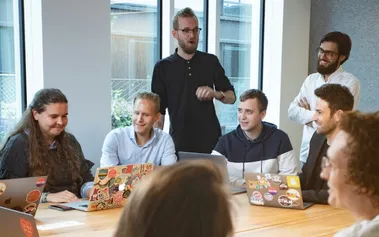Last autumn, I sat in on exit interviews at a Manchester-based fintech. Sarah, a senior backend engineer, had just handed in her notice. "But we celebrated you in our diversity report," the HR director said, genuinely confused.
Sarah's response stuck with me: "You hired me because I'm a woman in tech. But you never asked what I thought about our architecture decisions. My gender got me in the door, but my engineering skills were invisible."
Three other women engineers left that same month. All cited the same issue: being seen as diversity statistics rather than technical contributors.
Diversity metrics tell you who's in the room, but belonging determines who stays, contributes, and thrives. When talented engineers feel like tokens, your hiring efforts become a revolving door.
This article shows you how to shift from checkbox diversity to building genuine belonging. You'll get three immediate actions you can implement this week, plus warning signs that your current approach might be backfiring.
Why Your Diversity Targets Are Backfiring
The Diversity Hire Trap
When you celebrate hitting numerical targets, you create stigma for the people you're trying to support. "She only got promoted because she's Black" becomes whispered corridor conversation. Your diversity statistics make talented engineers feel reduced to demographic checkboxes.
Teams start asking their one woman engineer to speak for all women in technical planning sessions. That's tokenism dressed up as inclusion.
What the Data Shows
Companies focusing only on hiring metrics see 67% higher turnover among diverse hires, according to McKinsey's 2023 research. Your diversity statistics look impressive, but your retention rates tell a different story.
Talented engineers like Sarah leave because they feel like tokens, not team members. The "diversity fatigue" cycle kicks in—initiatives fail, teams become cynical about future efforts.
The Real Pattern
I've facilitated exit conversations with dozens of women engineers through my male allyship work. They don't leave because of overt discrimination. They leave because their technical contributions get overshadowed by their demographic characteristics.
One senior engineer told me: "I'm tired of being the woman who codes instead of the coder who happens to be a woman."
What Belonging Looks Like in Engineering Teams
Psychological Safety in Practice
Junior developers ask "Why did we choose React over Vue?" without being dismissed. Engineers challenge senior developers' database choices based on performance data, not hierarchy. Code reviews focus on "This could be more efficient" without feeling like personal attacks.
Belonging vs. Tolerance
Belonging means different perspectives get actively sought: "What would mobile performance look like with this approach?" Tolerance means diverse voices present in stand-ups, but architecture decisions happen in informal conversations afterward.
Belonging creates informal mentorship that crosses demographic lines naturally. Tolerance creates formal diversity programmes that feel performative.
Measure What Matters
Track whose technical suggestions get implemented, not just who speaks in meetings. Monitor promotion rates across different groups. Observe who gets included in critical system design discussions.
At a Birmingham startup I advised, women engineers' pull requests took 40% longer to get approved than men's for equivalent code quality. That data revealed unconscious bias in their technical processes—something diversity hiring statistics would never catch.
Three Daily Actions That Build Belonging
1. Change How You Run Technical Discussions
Start this week. Rotate meeting facilitation to amplify quieter voices. Implement "silent start" periods—begin architecture discussions with five minutes of individual note-taking before group discussion. This gives everyone time to formulate thoughts without competing for airtime.
Make "What perspectives are we missing?" a standard agenda item.
A Leeds-based consultancy rotates weekly tech talks among all engineers. Result: junior developers suggest solutions that seniors hadn't considered, and code quality improvements increased 23%.
2. Transform Your Code Review Culture
Separate technical feedback from style preferences. "This has O(n²) complexity" addresses performance. "I prefer different variable names" addresses personal taste.
Require reviewers to explain the "why" behind major change requests. Implement "appreciation comments" alongside improvement suggestions.
The Manchester fintech implemented "appreciation-first" code reviews. Each review includes one positive technical observation before suggesting improvements. Women engineers' satisfaction with peer feedback increased 45%.
3. Redesign Your Hiring Process
Replace "culture fit" questions with values-based scenarios. Instead of "Would you fit in with our team?", ask "Describe a time you defended a technical decision to stakeholders."
Ask candidates about learning from technical failures, not just successes. This reveals growth mindset, which predicts performance better than current skill level.
A London scale-up changed their final interview from informal conversations to technical mentorship scenarios. Their retention of diverse hires improved from 60% to 87% in the first year.
Your Next Steps
Belonging isn't built through hiring policies. It's created through daily technical interactions that value engineering contributions over demographic characteristics.
Your immediate action plan: This week, try the silent start technique in one technical meeting. This month, review your team's last ten code reviews for appreciation versus criticism ratio. Next quarter, audit one hiring process stage for unconscious bias.
The business case is clear. Teams with high psychological safety deliver 19% better technical results and retain talent 40% longer, according to Google's Project Aristotle findings. When engineers feel they belong based on technical contributions, they share their best thinking.
Start with the silent start technique in your next architecture discussion. Your team's engagement will show you it's working within weeks. Sarah and her colleagues shouldn't be the ones who got away—they should be the engineers whose technical insights make your products better.




